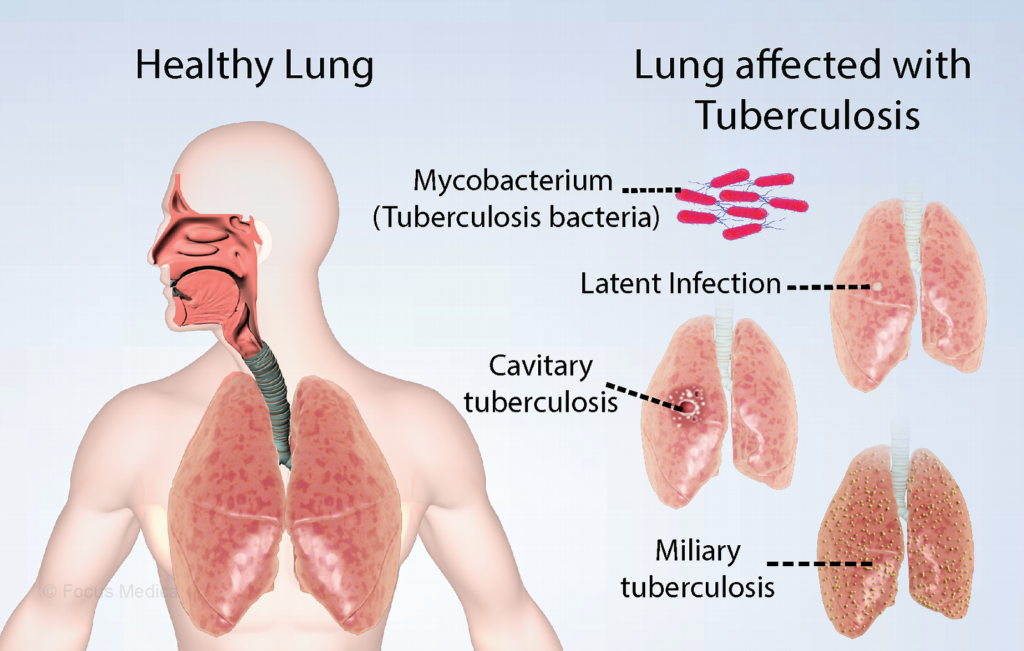Disseminated tuberculosis (TB) is a severe and widespread form of tuberculosis that can affect multiple organs and systems in the body. Unlike pulmonary tuberculosis, which primarily targets the lungs, disseminated TB, also referred to as miliary tuberculosis, can lead to the involvement of distant organs, such as the liver, kidneys, bones, and even the brain. This article delves into the details of disseminated TB, exploring its causes, symptoms, diagnostic methods, treatment options, and potential complications.

What is Disseminated Tuberculosis?
Disseminated tuberculosis occurs when Mycobacterium tuberculosis, the bacterium responsible for TB, spreads from the lungs to other parts of the body. The term “disseminated” refers to the spread of infection throughout the body via the bloodstream, leading to a condition called miliary tuberculosis. It can affect multiple organs simultaneously, making it a complex and dangerous illness that requires prompt medical intervention.
How Does Disseminated Tuberculosis Develop?
Disseminated TB typically develops when the immune system is weakened, either due to other underlying health conditions or treatments. In these situations, the body’s ability to contain the infection in the lungs is impaired, allowing the bacteria to enter the bloodstream and travel to other organs. Common risk factors for disseminated TB include HIV/AIDS, immunosuppressive therapies, malnutrition, and chronic illnesses.
Causes of Disseminated Tuberculosis
The primary cause of disseminated TB is Mycobacterium tuberculosis. This bacterium spreads through the air when an infected person coughs or sneezes. However, disseminated TB occurs when the bacteria escape the lungs and invade other organs. This can happen for a variety of reasons:
- Weakened Immune System: Conditions like HIV/AIDS or cancer treatment with immunosuppressive drugs can compromise the body’s defense system.
- Advanced Pulmonary Tuberculosis: If tuberculosis is left untreated in its early stages, it can progress to disseminated TB.
- Malnutrition: Malnutrition weakens the immune system, increasing the likelihood of the infection spreading.
Why is Disseminated TB Dangerous?
Disseminated TB can be fatal if not detected early. It spreads throughout the body, infecting various organs, which can lead to widespread complications. This progression often makes it difficult for healthcare providers to diagnose early, contributing to its severity.
Symptoms of Disseminated Tuberculosis
The symptoms of disseminated tuberculosis are varied and can differ depending on the organs affected. Common symptoms include:
- Fever and Night Sweats: These are hallmark signs of TB and are often the first to appear.
- Weight Loss and Fatigue: Patients with disseminated TB often experience unexplained weight loss and a persistent feeling of fatigue.
- Coughing and Chest Pain: While not as severe as in pulmonary TB, these symptoms can still occur if the lungs are involved.
- Organ-Specific Symptoms: If the liver or kidneys are affected, symptoms may include jaundice or abdominal pain. When the brain is infected, neurological symptoms such as headaches, confusion, or seizures may arise.
In advanced cases, disseminated TB can cause severe complications such as organ failure or permanent damage to affected tissues.
Diagnosis of Disseminated Tuberculosis
Diagnosing disseminated TB is challenging due to the diversity of symptoms and the fact that it mimics other systemic illnesses. However, early diagnosis is critical for effective treatment. Common diagnostic procedures include:
- Chest X-Ray: While chest X-rays may not always show disseminated TB, they can provide clues if the lungs are involved.
- Blood Tests: Blood cultures can help identify Mycobacterium tuberculosis, and other tests can evaluate the degree of infection and organ involvement.
- CT Scans and MRIs: Imaging techniques such as CT scans or MRIs are useful for detecting abnormalities in organs affected by the disease.
- Biopsy: In certain cases, a biopsy may be needed to confirm the diagnosis, particularly if organs like the liver or spleen are involved.
Molecular Tests
The use of advanced molecular tests, such as PCR (Polymerase Chain Reaction), can significantly reduce the time needed for diagnosis. These tests identify the genetic material of the bacteria directly from samples, helping to confirm the presence of Mycobacterium tuberculosis.
Treatment of Disseminated Tuberculosis
The treatment of disseminated TB is a lengthy and complex process. Unlike localized TB, which may require only a few months of treatment, disseminated TB often requires extended antibiotic therapy. The mainstay of treatment is a combination of antibiotics, which must be taken for at least six months to ensure full eradication of the bacteria.
First-Line Drugs for TB
The most commonly used drugs in treating TB include:
- Isoniazid: A drug that inhibits the growth of the bacteria.
- Rifampicin: A medication that helps to prevent the bacteria from multiplying.
- Pyrazinamide: A drug used to kill Mycobacterium tuberculosis during the initial phase of treatment.
- Ethambutol: This medication prevents the growth of the bacteria and is often used in combination with the other drugs.
Second-Line Drugs
For drug-resistant TB or in cases where the first-line drugs are ineffective, second-line drugs may be required. These include medications such as fluoroquinolones and injectable drugs like amikacin.
Surgical Intervention
In rare cases, surgery may be required to remove infected tissue or drain abscesses caused by disseminated TB.
Complications of Disseminated Tuberculosis
If left untreated or improperly managed, disseminated tuberculosis can lead to serious complications, including:
- Organ Damage: Severe infection of the kidneys, liver, or lungs may lead to permanent damage or organ failure.
- Meningitis: TB meningitis can result if the infection spreads to the brain, causing inflammation and potentially life-threatening complications.
- Sepsis: In severe cases, the widespread infection can lead to sepsis, a systemic response that can cause shock and death if not treated promptly.
Prognosis and Recovery
With early diagnosis and appropriate treatment, the prognosis for disseminated tuberculosis can be positive. However, recovery may be prolonged, and some patients may experience lingering symptoms such as fatigue or mild organ dysfunction.
Preventing Disseminated Tuberculosis
Prevention of disseminated TB primarily involves reducing the risk of contracting pulmonary tuberculosis, as early-stage TB can progress to a disseminated form. Key preventive measures include:
- Vaccination: The Bacillus Calmette-Guérin (BCG) vaccine is often used in countries with high TB prevalence to protect against severe forms of tuberculosis, including disseminated TB.
- Timely Diagnosis and Treatment: Prompt treatment of pulmonary TB can prevent its spread to other parts of the body.
- Improved Nutrition and Immune Support: Maintaining a healthy immune system is crucial for preventing the spread of TB.
MYHEALTHMAG

